Except as noted, article and photos by Joe Sapia
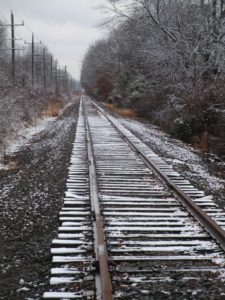
On the ConRail railroad tracks between Prospect Plains and Cranbury Station on the boundary of Cranbury and Monroe, Middlesex County.
JEEP-LESS, THE BAD: My Jeep Wrangler has been in the shop. A metal plate in the clutch area cracked. When mechanic-friend Frank Ulatowski told me the parts distributor said, I never ordered this part before, I knew this could be trouble. The part, being shipped from Detroit, finally did come in and Frank installed it, but the repair was set back by the need for a second part. The Jeep should be ready Monday. For the past week, though, my travels have been limited – generally confined to walking in my hometown of Monroe and the bordering towns of Helmetta, Spotswood, South Brunswick, Cranbury, and Jamesburg.
JEEP-LESS, THE GOOD: With no work scheduled, I decided to not rent a motor vehicle, instead hoofing it. I have thought about this for years – on my days not working, try to only walk or bicycle. So, I have been constantly walking, along with some bicycling. My longest walk was 11 miles – a trek home from the doctor’s office for a followup on my annual exam in Monroe (to which I taxied), with a detour to Teddy’s luncheonette in Cranbury and, later, supper in Helmetta. Aside from the health benefits of walking, it has taken me on routes less-traveled and slowed me to observe better. So, I have a lot of cool observations to pass along.
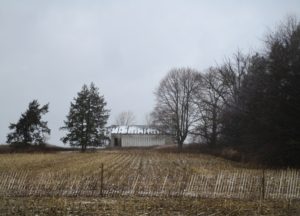
An old farm site in Cranbury.
SNOWFALL UPDATE: The two snowfalls on Tuesday, January 30, amounted to an estimated 1.0 inch of snowfall at my Monroe house. This brings the seasonal total to 18.0 inches. The normal season average is about 25.8 inches, recorded in New Brunswick, about 7-1/2 miles away; We still have about 2-1/2 months of snow potential to reach the average.
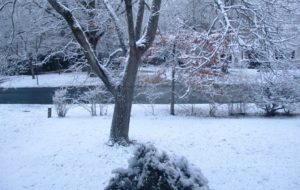
The view I awoke to, as seen from my bedroom window, on Tuesday, January 30, in Monroe.
‘POWDERED SUGAR’ SNOW: When I awoke Tuesday, January 30, I found a snowfall that looked as though the vegetation was covered with powdered sugar. It was a beautiful find to start the day!
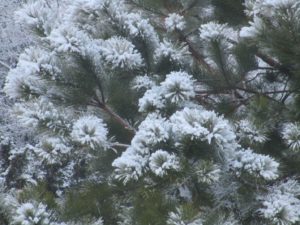
The “powdered sugar” snow on the pitch pine, “Pinus rigida,” in my backyard in Monroe.
NORTHERN HARRIERS, CONTINUED: I continue to see northern harriers, “Circus cyaneus,” more than I have ever seen. This week, I saw one at Helmetta Pond, Middlesesex County – the first time I recall seeing one there. Remember, as a nester, New Jersey lists them as “endangered,” or in imminent peril. Look for them hunting game by flying low above fields or marshes. They are sleek and have a white rump patch – females are brown, males are gray-white. As Roger Dreyling, birder extraordinaire from Monroe, noted, “I like harriers, especially males, which are sometimes called ‘gray ghosts.’”
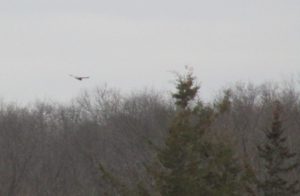
A female northern harrier at Helmetta Pond. Notice the white rump patch.
UPPER MILLSTONE RIVER EAGLES NEST: Anne Price and I, volunteers for the state Department of Environmental Protection, have been watching this nest. We agree it appears the eagles are incubating an egg or eggs. For example, I saw an eagle fly by the nest and perched nearby, while it appeared the other one was in the nest. Because bald eagles are a jeopardized species in New Jersey – “endangered,” or under imminent threat as a nester, and “threatened,” or could become “endangered” if conditions persist, in general – we are being discreet in identifying the location of the nest. (In the 2017 state eagles report, http://www.state.nj.us/dep/fgw/ensp/pdf/eglrpt17.pdf, this nest is listed as No. 184, “Upper Millstone.”)
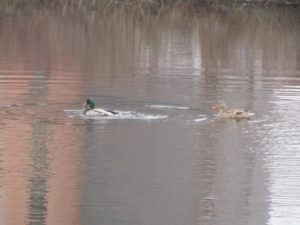
Mallard ducks, “Anas platyrhynchos,” at a fire-suppression pond at the former George W. Helme Snuff Mill in Helmetta. The more colorful male is on the left.
VOICES FROM AFIELD, EAGLE SIGHTINGS: I keep saying, if you want to see bald eagles, look up into the sky. Various reports came in during the week week. Michele Arminio of Monroe reported seeing a flying eagle at Milltown Road, between Route 18 and Ryders Lane, in East Brunswick. Janice Weinman reported seeing one at the South River and its wetlands on the boundary of Old Bridge, Sayreville, and East Brunswick: “Flying out of the marshlands area on the east side of Bordentown Avenue, flying towards east Brunswick. It was an adult as it had its white head, but not too big. I was surprised to see one there. I was not aware of any in that area.” Actually, this one could be nesting in the Old Bridge area. A pair, there, has repeatedly moved its nest and, last year, a nest could not be located. Paul Reed reported an eagle at Helmetta Pond. Roger Dreyling of Monroe reported an immature eagle at “Jamesburg Lake” (Lake Manalapan) in Monroe. Duke Farms in Hillsborough, Somerset County, has a camera on its eagle nest, http://dukefarms.org/making-an-impact/eagle-cam/.
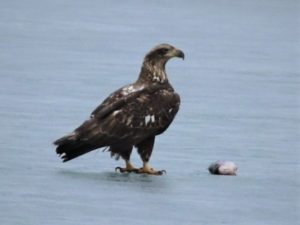
An immature bald eagle – notice the lack of white head and tail – with a fish at “Jamesburg Lake” (Lake Manalapan) in Monroe in January. (Photograph copyright 2018 by Roger Dreyling)
MUTE SWANS: Ugh, I dislike mute swans, “Cygnus olor,” non-natives that hurt local ecosystems through their aggressive eating of aquatic vegetation and scaring off native species. But they are naturalized here…. This week, I saw a pair at Helmetta Pond.
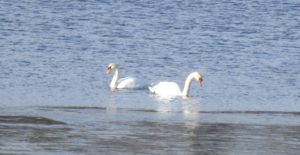
Mute swans on Helmetta Pond.
BACKYARD SHRUB PILE: I keep a pesticide- and fertilizer-free yard. It is only a quarter-acre, or about 10,000 square feet. But it is productive — a vegetable and fruit garden of more than 1,000 square feet, bird-feeders, bird baths. Roughly only 10 percent of rainwater drains off the property. One of the pro-environment bits of my property is the brush pile and tall-grass patch I keep in the backyard. The brush pile, for example, is a place for birds to retreat to and perch. This week, I photographed a few house sparrows, “Passer domesticus,” is the pile. (I was happy to see the brush pile being used, despite being used by house sparrows, a non-native species.)
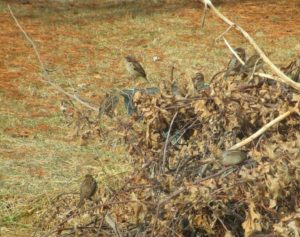
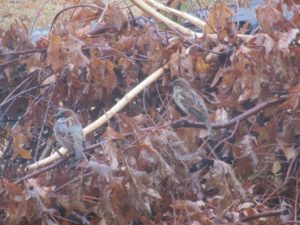
House sparrows in the backyard bush pile.
OTHER YARD BIRDS: I took random photos of various bird species in my yard: cardinal, “Cardinalis cardinalis”; dark-eyed juncos, “Junco hyemalis,” or “snowbirds”; red-bellied woodpecker, “Melanerpes carolinus”; and grackles, “Quiscalus quiscula.”
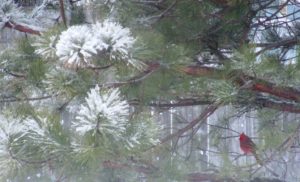
A cardinal, “Cardinalis cardinalis,” in the backyard pitch pine.
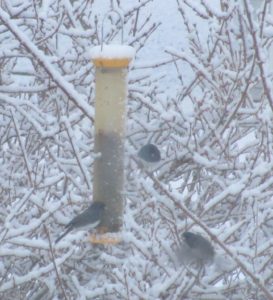
Snowbirds – one at the niger feeder, one perched nearby, one flying in.

Red-bellied woodpecker at the sunflower kernel feeder.
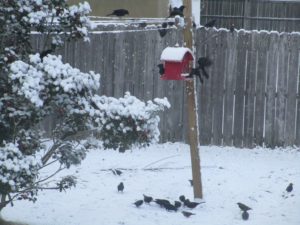
Grackles at the feeder.
VOICES FROM AFIELD, ROBINS: “Polish Paul” Migut, a friend going back to childhood, checked in on robins, “Turdus migratorius.” He, too, had them in his South River yard. “Thursday (February 1) morning, looking into my rear yard, spotted about 10 to 12 robins,” Paul said. “Looked very healthy, plump.” Again, some may consider a robin as a sign of spring, but they are year-around.
RED-TAILED HAWKS: This week, I was able to get some pretty close-up photographs of red-tailed hawks, “Buteo jamaicensis.” Looked for them perched, soaring with a creamy underbelly look and rust-colored tail, or a big bird flying and flapping its wings about a half-dozen times.
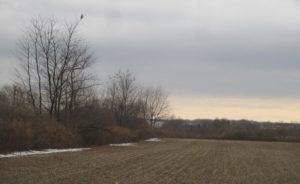
A red-tailed hawk perches in a tree and watches over farmland in South Brunswick.
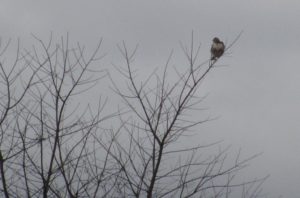
A closeup of the South Brunswick red-tailed hawk.
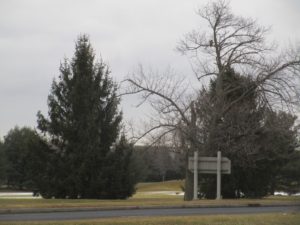
A red-tailed hawk perches in a tree near New Jersey Turnpike Exit 8-A in Monroe.
DEAD GREAT BLUE HERON: I was hiking in the Pine Barrens around Helmetta and at Cranberry Bog came across a dead blue heron, “Ardea Herodias.” It was lying on dry ground, inches from the water. Its eyes were in place and its body supple, so it probably was not dead all that long. I saw no obvious cause of death. Its anal area was ripped up a bit, but that likely was caused by a scavenger after death. I talked to Rick Lear, head of the Middlesex County Office of Parks and Recreation, about it and he speculated it died of starvation, because of the difficulty of finding food, such as aquatic animals and small mammals, this time of year.
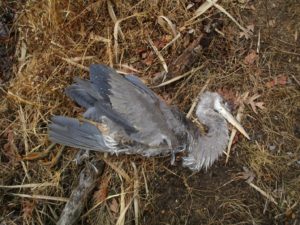
A great blue heron I found dead at Cranberry Bog in Monroe.
FARMLAND, DEVELOPABLE LAND: I recall saying, “Potatoes like dry feet and so do developers.” Well, look at this gravelly, or well-drained, farmland in South Brunswick. Nice developable land, unfortunately! Even more unfortunate is it being located on the New Jersey Turnpike, near an exit, 8-A.
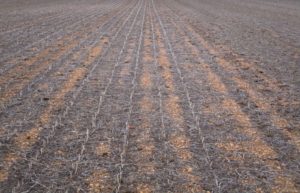
Gravelly farmland in South Brunswick.
PHRAGMITES: I am noticing a lot of invasive reed grass, genus “Phragmites.” This stuff really clogs wetlands and is difficult to control. It is not only bad for the environment, but also for drainage. Beware in heavy rain, this will contribute to flooding. And phragmites invasion is only getting worse, from what I see.
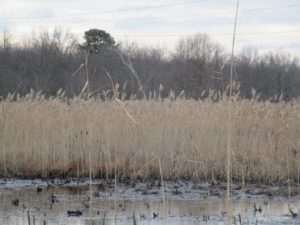
Phragmites clogging Cranberry Bog in Monroe.
BARKING FOX: One night, I stood in my yard and listened to this yip, yip, yip call from the woods or near the woods. It was a red fox, “Vulpes vulpes.” So, do not only look, but listen. Nature is all around us.
NON-POINT SOURCE POLLUTION: I was walking in the Manalapan Brook floodplain in Helmetta and there it was, non-point source pollution – garbage — that got into the water system and floated about. Ever seen those notices about garbage getting into storm drains? They really mean it. Throw a plastic bottle out of a car miles inland and, at least in theory, it could wind up in the ocean. Even if it does not wind up in the ocean, it could wind up in the freshwater system. And even if it does not do that, it is still litter.
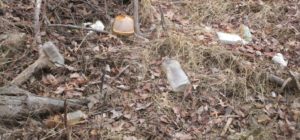
Non-point source pollution in the Manalapan Brook floodplain at Helmetta.
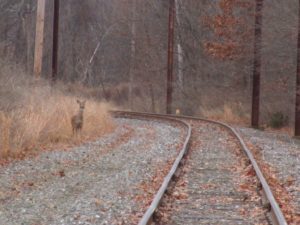
ATLANTIC OCEAN TEMPERATURES: The Atlantic Ocean temperature along the New Jersey coast was running at about 35 to 37 degrees on the February 3-4 weekend.
SUNRISE/SUNSET: From Sunday, February 4, to Saturday, February 10, the sun will rise about 7 a.m. and set 5:25 p.m. From Sunday, February 11, to Saturday, February 17, the sun will rise about 6:45 to 6:55 a.m. and set at about 5:30 to 5:35 p.m.
WEATHER: The National Weather Service forecasting office serving the Jersey Midlands is at http://www.weather.gov/phi/.
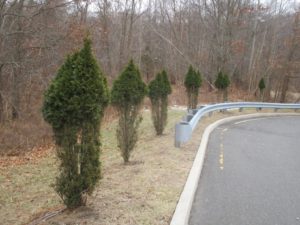
Deer damage to arbor vitae trees at the old George W. Helme Snuff Mill power plant in the Helmetta.
Joe Sapia, 61, is a lifelong resident of Monroe — in South Middlesex County, where his maternal family settled more than 100 years ago. He is a Pine Barrens naturalist and an organic gardener of vegetables and fruit, along with zinnias and roses. He draws inspiration on the Pine Barrens around Helmetta from his mother, Sophie Onda Sapia, who lived her whole life in these Pines, and his Polish-immigrant grandmother, Annie Poznanski Onda. He gardens the same backyard plot as did his Grandma Annie and Italian-American father, Joe Sr. Both are inspirations for his food gardening. Ma inspires his rose gardening. Joe is a semi-retired print journalist of almost 40 years. His work also is at @JosephSapia on Twitter.com, along with Facebook.com on the Jersey Midlands page.
Copyright 2018 by Joseph Sapia
Except where noted, article and photos by Joe Sapia
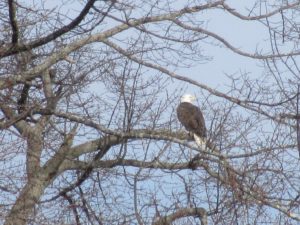
A bald eagle perched in a tree near its “Upper Millstone River” nest on the boundary of Middlesex and Mercer counties.
UPPER MILLSTONE RIVER EAGLE NEST: As the state Department of Environmental Protection monitors of the nest, Anne Price and I have been watching the pair of bald eagles, “Haliaeetus leucocephalus.” By week’s end, they were still in pre-nesting mode – flying in courtship, perched near each other near the nest, perched together on the nest. Stay tuned, there should be an egg or eggs during the week of January 28. Because bald eagles are a jeopardized species in New Jersey – “endangered,” or under imminent threat as a nester, and “threatened,” or could become “endangered” if conditions persist, in general – we are being discreet in identifying the location of the nest. (In the 2017 state eagles report, http://www.state.nj.us/dep/fgw/ensp/pdf/eglrpt17.pdf, this nest is listed as No. 184, “Upper Millstone.”)
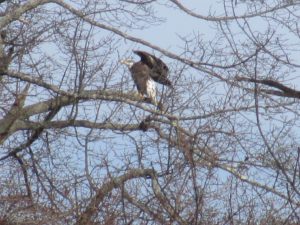
The eagle, spreading its wings, on a tree near the nest.
NORTHERN HARRIERS: I love northern harriers, “Circus cyaneus,” flying low above fields, searching for mammals to eat. They glide eloquently, putting on quite a show. This week, I was watching them on the Monroe-Cranbury boundary, Middlesex County – one at the wetlands mitigation bank at Cranbury Station, then around the wetlands mitigation bank at Wyckoff’s Mills. I did not get a good look at the Cranbury Station “marsh hawk,” but watched the Wyckoff’s Mills one for several minutes, flying back and forth, seemingly unbothered by me. The glimpse I got of the Cranbury Station harrier suggested it was a male, because it looked to be light-colored. The Wyckoff’s Mills harrier was a female – brown in color. Harriers, whether male or female, are easy to identify – flying within feet of the ground, sleek-bodied, having a white rump patch.
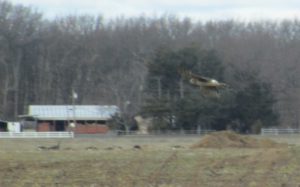
A northern harrier flies across farmland in at Wyckoff’s Mills on the Cranbury, Middlesex County, side of the road. Brown in color means it is a female. Notice the white rump patch females and males both have.

The female northern harrier flies above the wetlands mitigation bank on the Monroe side of the road at Wyckoff’s Mills, Middlesex County.

The female northern harrier flies on the Monroe side of the road at Wyckoff’s Mills, Middlesex County.
BLACK SQUIRRELS: If you want to see black squirrels, check out Princeton or Cranbury. Several years ago, I heard a story, although I do not know if it is true, that someone from Cranbury went to Princeton, trapped some black squirrels, and brought them to Cranbury. Actually, black squirrels are just a black phase of a gray squirrel, “Sciurus carolinensis.” Gray squirrels have no gray hairs — only white, black, and brown with the combination giving them a varied appearance.
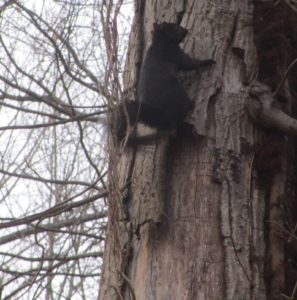
A black-phase gray squirrel in the woods between Wyckoff’s Mills and Cranbury Station in Cranbury, Middlesex County.
DEER IN THE DAYTIME: Twice in one day, I saw deer, “Odocoileus virginianus,” seemingly unbothered in the daytime in areas with a lot of human traffic. At noon, I saw one in a residential area on Riva Avenue, East Brunswick, Middlesex County. Then, 3-1/2 hours later, one was in a lawn area of Thompson Park, Monroe, Middlesex County. I thought this daytime lack of fear of these deer was brazen.
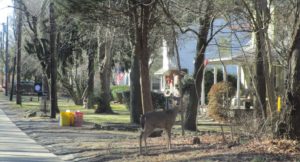
The deer on Riva Avenue in East Brunswick, Middlesex County.
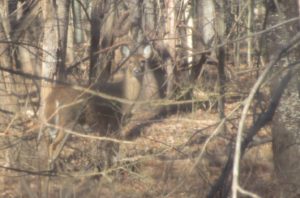
The East Brunswick deer fled me, then checked me out from the relative safety of the woods.
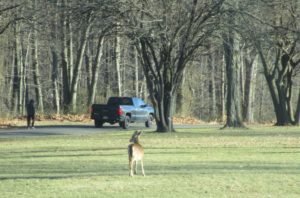
A deer in Thompson Park in Monroe, Middlesex County
ROBINS, A SIGN OF SPRING?: Some may think of robins, “Turdus migratorius,” are a sign of spring. But, actually, they are around in the winter. Perhaps more in the woods this time of year because of berries as a food source. Then, as it warms, with insects and worms becoming available, in our yards where we readily see them. But a little group of robins popped into my yard, across from woods, this week. (I have this affection for robins, because, I think, it was the first bird I learned to identify as a child.)
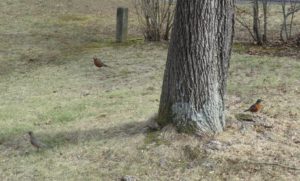
Robins in my front yard in Monroe, Middlesex County.
BIRDS, STARLINGS: Recently, I have noticed flocks of starlings, “Sturnus vulgaris.” The photograph shows them on farmland in Monroe, Middlesex County. (They are non-native, brought from Europe to North America in the 1800s and, now, naturalized here.)
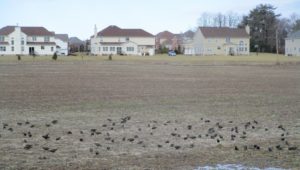
A flock of starlings on farmland in Monroe, Middlesex County.
YARD BIRDS: I was able crank off photographs of a white-throated sparrow, “Zonotrichia albicollis,” in one of my favorite bird-watching areas – through my living room window in Monroe, Middlesex County.
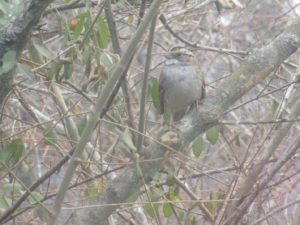
A white-throated sparrow in my front yard in Monroe, Middlesex County.
STINK BUGS: With the cold weather, I have an occasional brown marmorated stink bug, “Halyomorpha halys,” invading my house. I exterminate them. Their stink is not bad – more an earthy organic smell than a nauseating one. But they are highly invasive non-natives that could be devasting to farming. They have been documented for only about 20 years, believed to have arrived from East Asia to the Allentown, Pennsylvania, area via cargo. See https://njaes.rutgers.edu/stinkbug/.
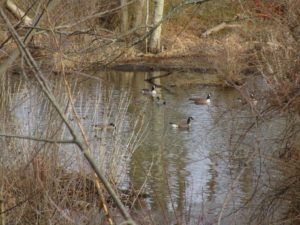
Canada geese, “Branta canadensis,” and mallard ducks, “Anas platyrhynchos,” along the Millstone River in East Windsor, Mercer County.
JERSEY MIDLANDS PRECARIOUS LOCATION: The beautiful Jersey Midlands are situated precariously between two major metropolitan areas, New York City and Philadelphia, and in the heart of the Boston-to-Richmond megalopolis. So, we are under development pressure. But, sometime, when we see our natural world beauty, we may forget how close we are. Reminders are the ongoing development (and destruction of the Midlands); traffic on the New Jersey Turnpike, Garden State Parkway and elsewhere; jets passing overhead.
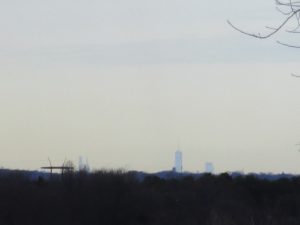
A view of the New York City skyline – the Freedom Tower, center, and the Empire State Building, just to the right of the utility line tower – through the eye of a point-and-shoot camera about 35 miles away from Redmond’s Hill at Thompson Park in Monroe, Middlesex County.
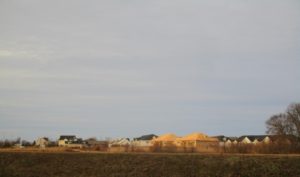
Here is an example of that development – in what I grew up calling “The Farms” of Monroe, Middlesex County.
PEGGY RENNER, ARCHERY CHAMP: I stumbled upon an obituary for Peggy Renner, who died this week. She and her family ran an archery-outdoors store in the Jamesburg-Monroe area for years. A salute to Peggy. Peggy’s obituary, http://www.legacy.com/obituaries/mycentraljersey/obituary.aspx?n=margaret-w-renner&pid=188001769&fhid=27060.
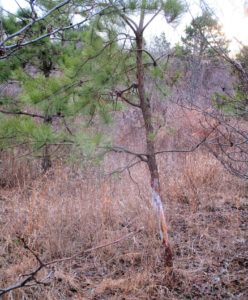
A deer rub of a male deer, “Odocoileus virginianus.” Bucks will rub the velvet off their antlers because they are hormonal and ready to mate, along with declaring their mating turfs. This is a pretty big rub, so there must be a pretty big buck around the Wyckoff Mills wetlands bank on the Monroe-Cranbury boundary, Middlesex County.
SWEET GUM TREE: Seeds from the pods of sweet gum, “Liquidambar styraciflua,” are a food for wildlife. This Internet site shows artsy uses for the seed pods, https://www.pinterest.com/beckyblue65/sweetgum-tree-seed-pods/.
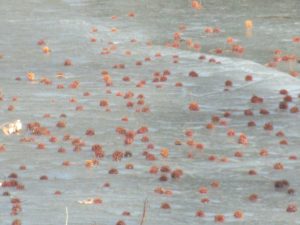
Seed pods of the sweet gum tree dot the ice of Devil’s Brook on the boundary of Plainsboro and South Brunswick, Middlesex County.
TURKEY VULTURES: We may note turkey vultures, “Cathartes aura,” flying V-winged or eating roadkill. They are a common bird. This week, I caught two interesting photos, one of them on a roadkill, the other in silhouette illustrating their look.
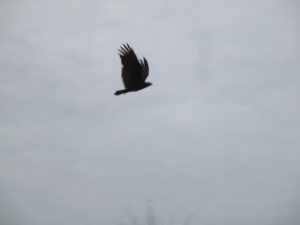
A turkey vulture. From Cornell University’s All About Birds website, “…They have long ‘fingers’ at their wingtips and long tails that extend past their toe tips in flight” — both evident in the photograph.
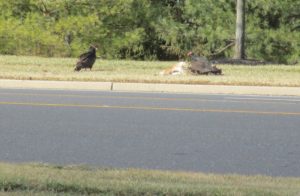
Turkey vultures on a deer carcass on Route 535 in Cranbury, Middlesex County.
SKY VIEWS: This week’s sky photographs are from Middlesex County – Cranbury and Monroe.
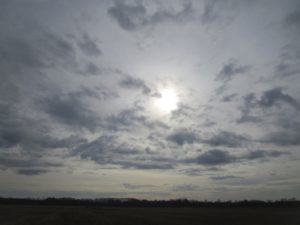
A farmland scene between Applegarth and Wyckoff’s Mills in Monroe, Middlesex County.
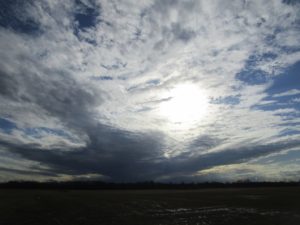
Again, a farmland scene between Applegarth and Wyckoff’s Mills in Monroe, Middlesex County.
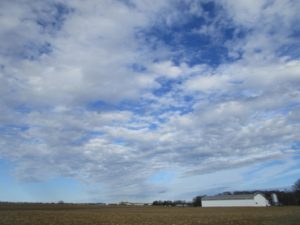
And, again, a farmland scene between Applegarth and Wyckoff’s Mills in Monroe, Middlesex County.

Wyckoff’s Mills farmland in Cranbury, Middlesex County.
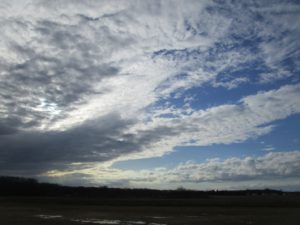
Looking toward Applegarth in Monroe, Middlesex County.
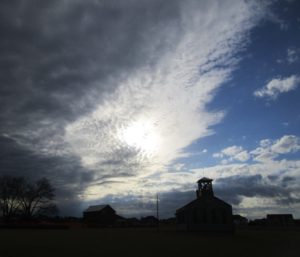
At the Dey Farm historic site in Monroe, Middlesex County.
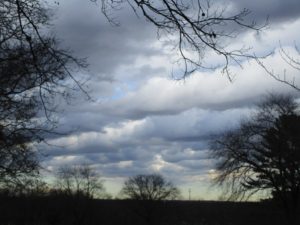
At Thompson Park in Monroe, Middlesex County.

At Saint James Cemetery in Monroe, Middlesex County.
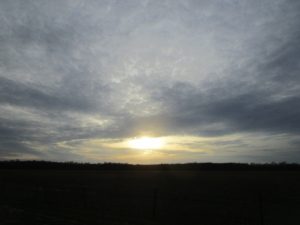
Farmland in Cranbury, Middlesex County.
ATLANTIC OCEAN TEMPERATURES: The Atlantic Ocean temperature along the New Jersey coast is running at about 35 or 36 degrees.
WEATHER: The National Weather Service forecasting office serving the Jersey Midlands is at http://www.weather.gov/phi/.
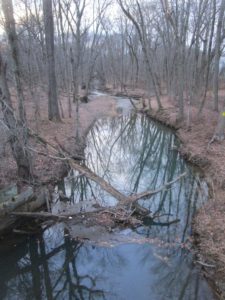
Cranbury Brook, here at Cranbury, Middlesex County, is part of the Raritan River watershed. Cranbury Brook runs from the Route 33 area at Millstone and Manalapan in Monmouth County.
SUNRISE/SUNSET: For Sunday, January 28, to Saturday, February 3, the sun will rise about 7:05 a.m. to 7:10 a.m. and set about 5:10 p.m. to 5:20 p.m.
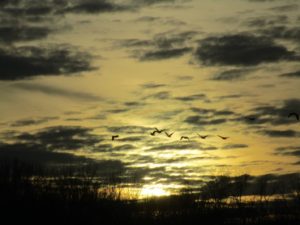
Canada geese flying at sunset on the border of Cranbury and Monroe, Middlesex County.
Joe Sapia, 61, is a lifelong resident of Monroe — in South Middlesex County, where his maternal family settled more than 100 years ago. He is a Pine Barrens naturalist and an organic gardener of vegetables and fruit, along with zinnias and roses. He draws inspiration on the Pine Barrens around Helmetta from his mother, Sophie Onda Sapia, who lived her whole life in these Pines, and his Polish-immigrant grandmother, Annie Poznanski Onda. He gardens the same backyard plot as did his Grandma Annie and Italian-American father, Joe Sr. Both are inspirations for his food gardening. Ma inspires his rose gardening. Joe is a semi-retired print journalist of almost 40 years. His work also is at @JosephSapia on Twitter.com, along with Facebook.com on the Jersey Midlands page.
Copyright 2018 by Joseph Sapia
Article and photos by Joe Sapia
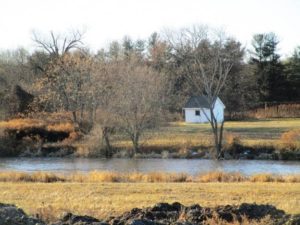
A farm outbuilding in Hopewell Township, Mercer County.
UPPER MILLSTONE RIVER EAGLE NEST: Last year’s pair of bald eagles, “Haliaeetus leucocephalus,” has returned to its nest along the Millstone River corridor on the boundary of Middlesex and Mercer counties. Last year, the nest fledged one eaglet. The state Endangered and Non-Game Species Program (within the Department of Environmental Protection’s Division of Fish and Wildlife) has named Anne Price, a professional naturalist and fellow Monroe, Middlesex County, resident, and me as the volunteer monitors for the nest. The eagles were still in pre-nesting phase, but we expect an egg or eggs to be laid any day now. More good news to follow next week. (In the 2017 state eagles report, http://www.state.nj.us/dep/fgw/ensp/pdf/eglrpt17.pdf, this nest is listed as No. 184.)
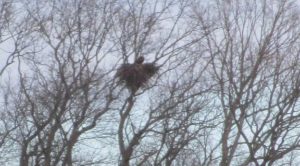
A bald eagle perched on the Upper Millstone River nest on the boundary of Mercer and Middlesex counties. This pair appears ready to lay an egg or eggs soon.
SNOWFALL: The Wednesday, January 17, snowfall in the part of Monroe between Jamesburg and Helmetta, Middlesex County, was about 1.0 inches, bringing the seasonal total to about 17.0 inches. (The seasonal average, measured at New Brunswick about 7.5 miles away, is 25.8 inches. So, we need only about 9 more inches to hit the average and we have about 3 months of snow time left.)
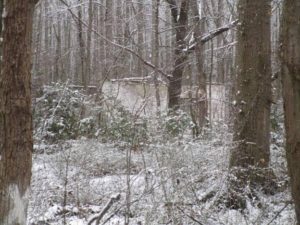
Snowy woods with an abandoned building on Federal Road in Monroe, Middlesex County.
SNOWFENCING: I have talked about snowfencing in open areas before and how it prevents drifting on roadways. Also, I have posted photos. But, perhaps, the post-snowfall scene best describes snowfencing, how snow is deposited on the downwind side. A photograph of the post-snowfall scene:
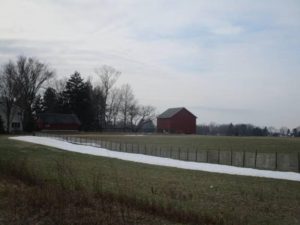
Here, on Main Street in Cranbury, Middlesex County, snow has deposited on the downwind side of the snowfencing. This same concept is used to contain blowing sand on beaches.
CANADA GEESE: I have been seeing a lot of Canada geese, “Branta canadensis,” on farmland, presumably helping themselves to leftover field corn in these fields. And I keep an eye out to see if there is anything else mixed in with these Canadas, perhaps a snow goose, “Chen caerulescens.”
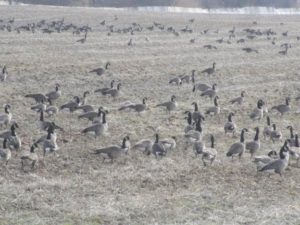
Canada geese on farmland in Cranbury, Middlesex County.
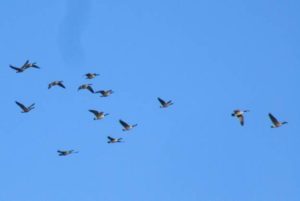
Canada geese flying in Hopewell Township, Mercer County.
BIRDS AROUND THE YARD: We have an incredible world of nature around us in New Jersey. We are at a prime location, where northern and southern animal and plant species meet. One easy thing to do is take time to view the birds in one’s yard. I feed them, using sunflower kernels/hearts nyger. (Last year, though, I stopped feeding birds in the summer, letting them serve as a natural pesticide in my yard. This year, I may extend this feeding ban beyond June, July, and August to a greater gardening period.)
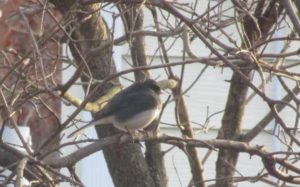
It is a “snowbird” – or dark-eyed junco, “Junco hyemalis” – but it is bundled up against the cold. This junco, in an oak, genus “Quercus,” in my sideyard, has its feathers fluffed to protect it against the cold.
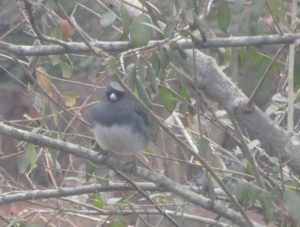
This photograph shows the “dark-eyed” in this dark-eyed junco. This bush in front of my living room window is a fun place to watch birds.
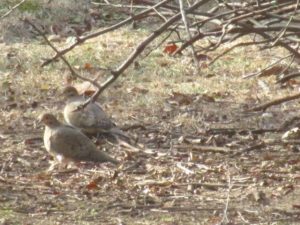
Mourning doves, “Zenaida macroura,” huddled under the flowering quince bush in my backyard.
COASTAL PLAIN BODIES OF WATER: The Jersey Midlands is divided into two geological provinces – the rolling and rocky Piedmont to the west and the flatland, either sandy or gravely, to the east. (The Coastal Plain can be divided into the Outer, or sandy, white soils of the Pine Barrens and beach, and the Inner, the darker, gravely soil conventional farming areas. For the sake of this story, we will talk of the Coastal Plain as one province.) Because of its flatness, there are few, if any, natural bodies of water on the Coastal Plain; Instead, they are human-made, often by dams holding back waterways. In Middlesex County, on the boundary of Helmetta, Monroe, and Spotswood, there is now-dry Lake Marguerite. It was formed by the damming of Manalapan Brook, but has been dry since the 1920s or so. The other day I shot photographs of its old dam.

The remnant of the Lake Marguerite dam on Daniel Road-10th Street on the boundary or Spotswood and Monroe, Middlesex County.

The circa 1906-1907 Lake Marguerite dam.
“OLD JERSEY”: As the Jersey Midlands develop, I am glad to run across “Old Jersey” remnants. Across the street from my house is one of them with an environmental twist – a “Prevent Forest Fires” sign. This sign might be the same one I have seen over all my 61 years. (Just to point out: There has been a different way of thinking on fire. For example, fire is good for the ecology of the Pine Barrens, such as where I live; But it is bad for people.)
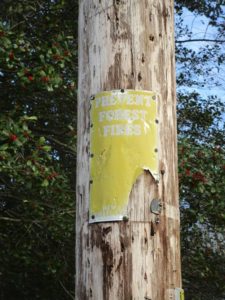
An old “Prevent Forest Fires” sign in my Monroe, Middlesex County, neighborhood.
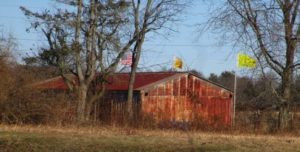
Another “Old Jersey” scene: a farm in Hopewell Township, Mercer County.
SKY VIEWS: This week’s sky views are from Monroe, Middlesex County, and the Manalapan-Freehold Township boundary, Monmouth County.

Monmouth Battlefield State Park on the boundary of Freehold Township and Manalapan, Monmouth County.

Monroe, between Applegarth and Wyckoff’s Mills.
ATLANTIC OCEAN TEMPERATURES: The Atlantic Ocean temperature in New Jersey ranged from about 36 to 37 degrees.
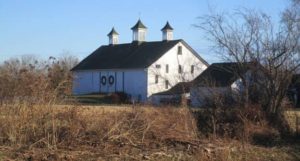
More farming from Hopewell Township Mercer County.
WEATHER: The National Weather Service forecasting office serving the Jersey Midlands is at http://www.weather.gov/phi/.
SUNRISE/SUNSET: For Sunday, January 21, to Saturday, January 27, the sun will rise about 7:10 to 7:15 a.m. and set about 5:05 to 5:10 p.m. For Sunday, January 28, to Saturday, February 3, the sun will rise about 7:05 a.m. to 7:10 a.m. and set about 5:10 p.m. to 5:20 p.m.
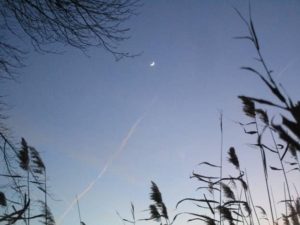
The crescent moon over Helmetta Pond, Middlesex County. The crescent moon is waxing toward the January 31 Full Snow Moon.
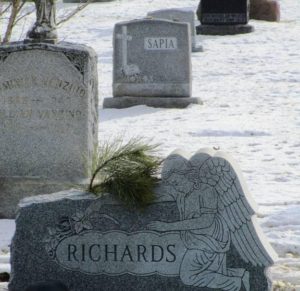
Ralph “Rusty” Richards, 85-years-old, a mentor of mine in the Pine Barrens around Helmetta, was buried this week in St. James Cemetery in the part of Monroe between Helmetta and Jamesburg, Middlesex County. As his obituary read, “He was an avid woodsman with an extensive knowledge of the local pine barrens….” I left this bough of pitch pine, “Pinus rigida,” the most common pine in the New Jersey Pine Barrens, on Rusty and his wife’s, Mona’s, gravestone. The cemetery is in my neighborhood and Rusty’s grave is a neighbor of my parents’s, Joe Sr. and Sophie Onda Sapia’s, grave. (My maternal family, the Onda-Poznanski family, has known the Richards family for 100 or so years.)
— Joseph Sapia
2018, January 21, Sunday,
A woodsman of the Pine Barrens of Helmetta
Joe Sapia, 61, is a lifelong resident of Monroe — in South Middlesex County, where his maternal family settled more than 100 years ago. He is a Pine Barrens naturalist and an organic gardener of vegetables and fruit, along with zinnias and roses. He draws inspiration on the Pine Barrens around Helmetta from his mother, Sophie Onda Sapia, who lived her whole life in these Pines, and his Polish-immigrant grandmother, Annie Poznanski Onda. He gardens the same backyard plot as did his Grandma Annie and Italian-American father, Joe Sr. Both are inspirations for his food gardening. Ma inspires his rose gardening. Joe is a semi-retired print journalist of almost 40 years. His work also is at @JosephSapia on Twitter.com, along with Facebook.com on the Jersey Midlands page.
Copyright 2018 by Joseph Sapia







































































